


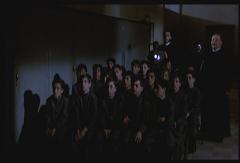
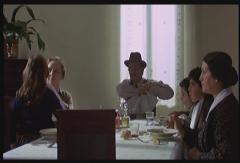


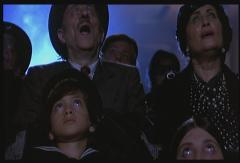
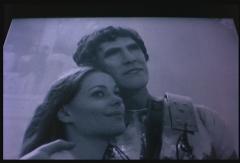
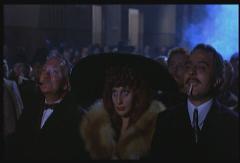






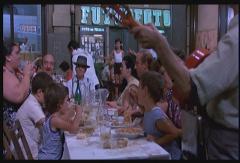
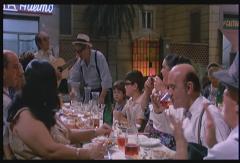





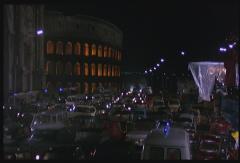













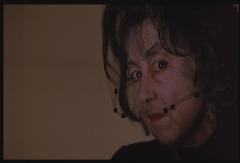
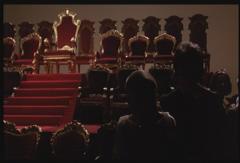



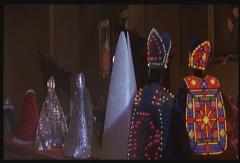





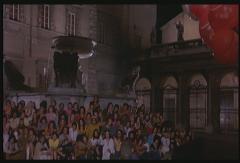





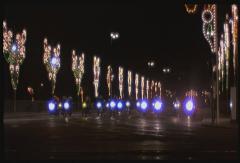

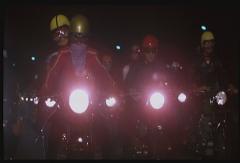

Fellini's Roma
Early in the ‘30s, a young man who’s staying at a boarding school run by priests imagines Rome based on his teachers’ statements and the Fascist regime’s rhetoric. In 1939, when he turns twenty, he goes to Rome and discovers the city’s real nature: people living in a cheap hotels, popular restaurants outdoors, children playing on the streets. Then, in 1972, there are massive traffic jams in the ring-road, and Fellini is shooting a film in a city crowded with tourists. He’s criticized by young people who claim is not interested in politics. This reminds us of a small variety show theatre, where viewers are running away because of an air-raid warning. Then the scene is set at an underground construction site, when works have to be stopped because some archeological remains are found. Then hippies gathering in Piazza di Spagna are shown, followed by the clients of a brothel in the Forties. There is also a clergy fashion show, a party in Trastevere (“festa de noantri”), and a real mess, with policemen clubbing people and bikers riding in the night.
Crew
Cast
Awards
Peculiarites
Reviews
- strict warning: Only variables should be passed by reference in /home/fellini/domains/federicofellini.it/public_html/sites/all/modules/date/date_api.module on line 866.
- strict warning: Only variables should be passed by reference in /home/fellini/domains/federicofellini.it/public_html/sites/all/modules/date/date_api.module on line 866.
- strict warning: Non-static method view::load() should not be called statically in /home/fellini/domains/federicofellini.it/public_html/sites/all/modules/views/views.module on line 906.
- strict warning: Declaration of views_handler_argument::init() should be compatible with views_handler::init(&$view, $options) in /home/fellini/domains/federicofellini.it/public_html/sites/all/modules/views/handlers/views_handler_argument.inc on line 744.
- strict warning: Declaration of semanticviews_plugin_style_default::options() should be compatible with views_object::options() in /home/fellini/domains/federicofellini.it/public_html/sites/all/modules/semanticviews/semanticviews_plugin_style_default.inc on line 232.
- strict warning: Declaration of views_plugin_row::options_validate() should be compatible with views_plugin::options_validate(&$form, &$form_state) in /home/fellini/domains/federicofellini.it/public_html/sites/all/modules/views/plugins/views_plugin_row.inc on line 134.
- strict warning: Declaration of views_plugin_row::options_submit() should be compatible with views_plugin::options_submit(&$form, &$form_state) in /home/fellini/domains/federicofellini.it/public_html/sites/all/modules/views/plugins/views_plugin_row.inc on line 134.
- strict warning: Declaration of semanticviews_plugin_row_fields::options_validate() should be compatible with views_plugin_row::options_validate($form, &$form_state) in /home/fellini/domains/federicofellini.it/public_html/sites/all/modules/semanticviews/semanticviews_plugin_row_fields.inc on line 117.
- strict warning: Non-static method view::load() should not be called statically in /home/fellini/domains/federicofellini.it/public_html/sites/all/modules/views/views.module on line 906.
- strict warning: Declaration of views_handler_filter::options_validate() should be compatible with views_handler::options_validate($form, &$form_state) in /home/fellini/domains/federicofellini.it/public_html/sites/all/modules/views/handlers/views_handler_filter.inc on line 607.
- strict warning: Declaration of views_handler_filter::options_submit() should be compatible with views_handler::options_submit($form, &$form_state) in /home/fellini/domains/federicofellini.it/public_html/sites/all/modules/views/handlers/views_handler_filter.inc on line 607.

